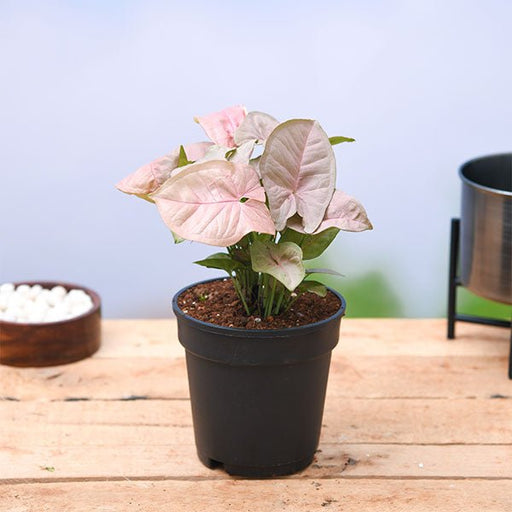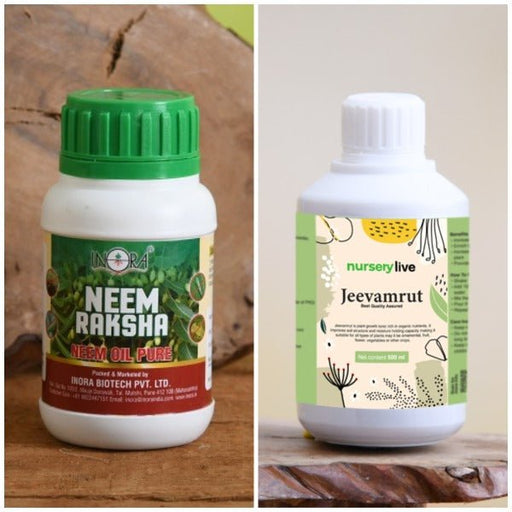
Bharangee (Bharangi) - Plant
(MRP Inclusive of all taxes)
- Shipping ₹79 for entire order
- Dispatch in 7 days
- Country of origin: India

(MRP Inclusive of all taxes)

Bring home a little green delight — on us! 🌿 A free surprise garden product with every order Could be a charming plant, vibrant seeds, stylish po...
View full details
 Save up to 15%
Save up to 15%
Peace Lily, Spathiphyllum - Plant The Peace Lily, scientifically known as Spathiphyllum, is a stunning houseplant celebrated for its elegant white...
View full details
 Save 17%
Save 17%
Beautiful Fragrant Mogra, Arabian Jasmine Plant with Pot The Beautiful Fragrant Mogra, also known as Arabian Jasmine (Jasminum sambac), is...
View full details
 Save up to 20%
Save up to 20%
Elephant Bush, Portulacaria afra, Jade Plant (Green) - Succulent Plant The Elephant Bush, scientifically known as Portulacaria afra, is a ...
View full details
 Save up to 20%
Save up to 20%
Syngonium (Pink) - Plant The Syngonium (Pink), also known as the Pink Arrowhead Plant, is a stunning tropical houseplant that captivates with its ...
View full details
 Sold out
Sold out
Citronella, Odomas - Plant The Citronella plant, scientifically known as Cymbopogon nardus, is a tropical grass renowned for its aromatic ...
View full details
 Save 17%
Save 17%
Rajnigandha, Tuberose - Plant The Rajnigandha, scientifically known as Polianthes tuberosa, is a captivating perennial plant renowned for ...
View full details Save 15%
Save 15%
Pack of Vermicompost and Neem Cake for House Plants Transform your indoor garden with our premium Pack of Vermicompost and Neem Cake, spec...
View full details
Pack of Plant Growth and Flower Boosters Unlock the full potential of your garden with our Pack of Plant Growth and Flower Boosters! This ...
View full details Save 38%
Save 38%
Combo of Jeevamrut and Neem Raksha for Easy Growth and Protection of Houseplants Transform your indoor garden with our exclusive combo of ...
View full details Save 22%
Save 22%
Plant Nutrients Kit (Pack of 16) for a Healthy Garden Transform your garden into a lush paradise with our Plant Nutrients Kit, featuring 1...
View full details Save 16%
Save 16%
Combo of Top Plant Fertilizers Elevate your gardening game with our exclusive Combo of Top Plant Fertilizers, featuring two bags of premiu...
View full details Save 24%
Save 24%
Pack of 4 Additives to Make Soil Healthy and Nutrient Rich Transform your garden into a thriving ecosystem with our Pack of 4 Additives de...
View full details Save 30%
Save 30%
Transform your gardening experience with our premium Combo of Perlite and Vermiculite. This unique blend is designed to enhance soil aeration and ...
View full details Save 27%
Save 27%
Combo of 2 Vermicompost and Cocopeat - Enrich Your Soil Naturally! Transform your garden into a thriving ecosystem with our Combo of 2 Ver...
View full details
 Save 35%
Save 35%
Best 6 Plants for Perfect Indoor Garden Transform your living space into a lush oasis with our curated collection of the Best 6 Plants for a...
View full details
 Save up to 50%
Save up to 50%
Mini Succulent Garden Pack Transform your space with our Mini Succulent Garden Pack, featuring a delightful collection of 4 any variety beautiful s...
View full details
 Save 30%
Save 30%
5 Best Fragrant Plants Transform your garden or indoor space into a fragrant paradise with our curated selection of the 5 Best Fragrant Plants. Th...
View full details
 Save 24%
Save 24%
Set of 2 Bonsai Looking Grafted Adeniums Transform your indoor or outdoor space with our exquisite Set of 2 Bonsai Looking Grafted Adenium...
View full details Save 45%
Save 45%
Top 4 Die Hard Succulents Pack Transform your indoor or outdoor space with our Top 4 Die Hard Succulents Pack, featuring a curated selecti...
View full details
 Save 30%
Save 30%
5 Best Indoor Plants Pack Transform your living space into a lush oasis with our '5 Best Indoor Plants Pack.' This carefully curated collection fe...
View full details
 Save 25%
Save 25%
Set of 4 Evergreen Air Purifier Plant Pack Transform your indoor space into a lush, green oasis with our Set of 4 Evergreen Air Purifier Pla...
View full details| SrNo | Item Name |
|---|---|
| 1 | Bharangee (Bharangi) - Plant |
The Bharangee, also known as Bharangi (scientific name: Clerodendrum serratum), is a remarkable perennial shrub native to tropical regions. This plant is celebrated for its vibrant flowers and medicinal properties, making it a popular choice among gardeners and herbalists alike. With its lush green foliage and striking clusters of white and purple blooms, the Bharangee adds a touch of elegance to any garden or landscape.
What makes the Bharangee special is its rich history in traditional medicine, particularly in Ayurveda, where it is revered for its anti-inflammatory and analgesic properties. Additionally, it attracts pollinators like bees and butterflies, contributing positively to the ecosystem. Its ability to thrive in various soil types and conditions makes it a resilient choice for both novice and experienced gardeners.
One of the standout features of the Bharangee is its aromatic leaves, which release a pleasant fragrance when crushed. This plant not only enhances the beauty of your garden but also serves as a natural air purifier, improving the overall environment. Its adaptability and low maintenance requirements make it an ideal addition to any green space.
If you think Bharangee is just another pretty plant, think again! This green wonder is a powerhouse of benefits. From purifying the air to attracting pollinators, it’s like the eco-friendly superhero of your garden. Plus, its medicinal properties can help with everything from skin ailments to digestive issues. Who knew a plant could be so multi-talented?
Caring for your Bharangee is easier than convincing your cat to ignore that laser pointer. Just give it well-drained soil, moderate sunlight, and a sprinkle of love. Water it when the top inch of soil feels dry, and watch it thrive like it’s auditioning for a botanical reality show.
Planting Bharangee is like setting up a new roommate—choose the right spot, give it some space, and don’t forget to check in on it! Ideally, plant it in a sunny location with good drainage. Dig a hole, place the sapling, and cover it with soil like tucking it into bed.
If you’re impatient, you might want to look away. Bharangee grows at a moderate pace, so don’t expect it to turn into a giant overnight. But with a little patience and care, it’ll reward you with lush foliage and vibrant blooms, proving that good things come to those who wait.
Want to multiply your Bharangee like rabbits? Propagation is the way to go! You can do it through seeds or cuttings. Just snip a healthy branch, let it callous over, and plant it in soil. Soon, you’ll have a mini Bharangee army ready to take over your garden.
Every plant has its enemies, and Bharangee is no exception. Watch out for aphids and spider mites—they’re like the uninvited guests at a party. Keep your plant healthy with regular checks and natural pest control methods, and you’ll keep those pests at bay.
Bharangee is not picky, but it does have standards. It prefers well-draining soil that’s rich in organic matter. Think of it as the Goldilocks of plants—not too sandy, not too clayey, but just right!
This plant loves to bask in the sun like a beachgoer on vacation. Ideally, it needs at least 6 hours of sunlight a day. Too little, and it might sulk; too much, and it could get scorched. Find that sweet spot, and your Bharangee will be all smiles.
Watering Bharangee is like a first date—don’t overdo it! Allow the top inch of soil to dry out before giving it a drink. Too much water, and you risk drowning your new green friend. Aim for a balanced schedule, and you’ll keep the romance alive.
Beyond its beauty, Bharangee has a plethora of uses. From traditional medicine to natural dye, this plant is a jack-of-all-trades. It’s like the Swiss Army knife of the plant world—versatile, handy, and always ready to impress.
If you want to elevate your landscaping game, Bharangee is your go-to plant. Its striking appearance can add a pop of color and texture to any garden. Use it as a focal point or as part of a mixed border, and watch your outdoor space transform into a botanical masterpiece.
In many cultures, Bharangee is more than just a plant; it’s a symbol of resilience and beauty. Often featured in folklore and traditional practices, it carries a rich history that adds depth to your garden. Planting it is like inviting a piece of culture into your home.
Bharangee, also known as Bharangi, is a delightful herb that’s like nature’s little pharmacy. With its vibrant green leaves and aromatic charm, it’s not just a pretty face; it’s packed with medicinal properties that can make you feel like a wellness wizard. Who knew plants could be so magical
Bharangee loves to hang out in tropical and subtropical climates, thriving in warm, sunny spots. Think of it as the sunbather of the plant world, soaking up rays and spreading good vibes. If you’re in India or similar regions, you might just find this herb lounging in your backyard!
Bharangee is like a Swiss Army knife for health! It’s known for its anti-inflammatory, antimicrobial, and digestive properties. Whether you’re battling a cold or just need a little pick-me-up, this herb has your back. Who needs a superhero when you have Bharangee in your garden
Using Bharangee is as easy as pie! You can brew it into a tea, toss it in salads, or even use it in soups. It’s like the versatile friend who can fit in anywhere. Just remember, a little goes a long way, so don’t overdo it unless you want a herbal party!
While Bharangee is generally safe, it’s always wise to check with your doctor before diving in, especially if you’re pregnant or on medication. Think of it as asking for permission before borrowing your friend’s favorite sweater. Better safe than sorry, right
Absolutely! Bharangee can be a fabulous indoor companion. Just give it a sunny spot, some well-draining soil, and a sprinkle of love. It’s like having a little green friend that not only beautifies your space but also boosts your health. Who wouldn’t want that
Bharangee prefers a Goldilocks approach to watering—not too much, not too little. Aim for moist soil but avoid soggy situations. Water it when the top inch feels dry, and your plant will thrive like it’s on a spa retreat. Hydration is key, but don’t drown it!
Bharangee can attract the usual suspects: aphids, spider mites, and whiteflies. Think of them as uninvited guests crashing your plant party. Keep an eye out and use natural remedies like neem oil to send them packing. Your Bharangee deserves a pest-free zone!
Absolutely! Bharangee adds a unique flavor to dishes, making it a culinary superstar. Use it in curries, soups, or even as a garnish. It’s like the secret ingredient that elevates your cooking game. Your taste buds will thank you for inviting this herb to dinner!
With proper care, Bharangee can live for several years, becoming a long-term companion in your garden. It’s like the friend who sticks around through thick and thin. Just give it the right conditions, and it’ll keep on giving, year after year!
Yes, Bharangee is like the low-maintenance friend we all need. It thrives with minimal fuss, requiring just sunlight, water, and occasional pruning. Even if you have a black thumb, this herb is forgiving. It’s the perfect plant for those who want greenery without the drama!